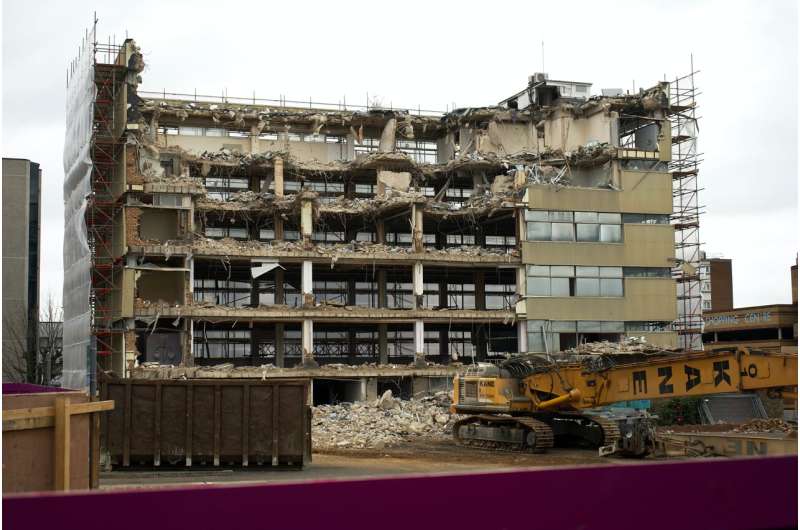This article has been reviewed according to Science X's editorial process and policies. Editors have highlighted the following attributes while ensuring the content's credibility:
fact-checked
trusted source
proofread
Five ways retrofitting cities can help decarbonize our future

Australian cities are not equipped to deal with the shocks and stresses of the near future.
We are seeing high levels of carbon emission, high-cost energy consumption, and the effects of climate change on human and non-human dwellers of the built environment.
The construction industry is geared towards constructing new buildings, however retrofitting rather than demolishing existing buildings would drastically reduce the economic and environmental price we are currently paying.
Researchers Dr. Judy Bush, Professor Sarah Bell and Enzo Lara-Hamilton of the Melbourne Center for Cities at the University of Melbourne recently published an issues paper, "Retrofitting for Cities: Challenges and Opportunities in Australia," to highlight challenges and outline potential solutions.
Here are five ways they say retrofitting provides a blueprint for the sustainable development of Australian cities.
1. Significantly reduce carbon emissions
Upgrading existing buildings and infrastructure reduces embodied and operational carbon emissions. Embodied carbon emissions are the pollution that occurs as a by-product of the materials used and the construction of a building, while operational emissions are those produced during the day-to-day running of the building.
The material footprint of Australia's existing buildings is estimated at 3.8 billion tons of material which emitted 1804 million tons of CO₂, and consumed massive amounts of energy and water when built. By retrofitting existing structures according to new sustainability standards, future emissions of this scale can be avoided or drastically reduced.
The landmark retrofit project Quay Quarter Tower in Sydney used 98% of the original structural walls and core and 65% of the existing floor plates to save an estimated 12,000 tons of embodied carbon when compared to demolishing and re-building.
Researchers at the University of Melbourne's Faculty of Architecture, Building and Planning have developed a suite of design tools that enable industry stakeholders to make better-informed choices about how their choice of materials can improve the environmental performance of construction projects.
2. Increase biodiversity and improve disaster readiness
Urban development has contributed to a significant loss of green space and biodiversity. This has resulted in a loss of urban habitat for plants and animals and a lack of shade and habitable public space for urban dwellers.
Increasing 'green infrastructure' in the form of green roofs and walls—alongside more trees, parks and gardens—can deliver multiple benefits including urban cooling and positive health outcomes.
The City of Melbourne's Urban Forest Strategy lays out their 20-year plan to implement green infrastructure across the city. To help with this they have developed the Green Factor Tool, a web-based, open access green infrastructure tool for new developments.
As we face increasingly frequent and intense extreme weather events, it is vital that we adapt cities to be prepared for pandemics, heat waves, storms, floods and drought.
Modifying existing infrastructure to mitigate the impact of these events aligns with the Climate Resilient Development framework proposed by the Intergovernmental Panel on Climate Change.
3. Reducing costs and increasing productivity
Retrofitting can provide positive economic impacts through the creation of high-quality jobs, with less labor required and lower material costs for retrofit projects compared with new builds.
There is also an opportunity to significantly reduce building and infrastructure operational costs and to improve rental yield through increased quality of amenities leading to higher paying tenants.
Beyond Zero Emissions has released a Million Jobs Plan that shows how switching Australia to a low-carbon economy could provide 1,778,000 job years over 5 years. Retrofitting buildings and transport, land regeneration, and subsequent training account for 713,500 job years in this estimation.
4. Improve overall health outcomes
Retrofitting houses creates healthier and more efficient homes. The internal environmental quality (IEQ) of a building can be improved by increasing thermal comfort and changing the functional requirements of buildings for aging populations and people with disabilities.
The Australian Sustainable Built Environment Council (ASBEC) estimates that with the right policies and actions Australia's building sector could deliver up to 28 percent of Australia's 2030 emissions reduction target, while creating healthier, more productive cities.
An example is the BREATH project, led by researchers at the Faculty of Engineering and Information Technology at the University of Melbourne, which considered the cost and energy use associated with ventilation systems in buildings as a measure to reduce COVID-19 transmission.
5. Avoiding obsolescence
A major benefit of retrofitting is avoiding the obsolescence of older buildings through their diminishing usefulness and performance. This can help us to retain historical buildings while improving environmental performance.
For example, adapting existing offices to accommodate flexible working can mitigate the financial impacts of changing work habits since the COVID-19 pandemic, retain historical buildings and improve environmental performance.
Making improvements to existing housing, rather than demolishing it, retains tenants who would otherwise be at risk of displacement due to urban renewal projects. The Ellebo Garden Room in Copenhagen is an award-winning example of how public housing can be upgraded to achieve modern standards of energy efficiency and comfort while maintaining communities.
By rapidly improving the sustainability of our existing buildings and infrastructure through retrofit strategies, we can achieve modern standards of efficiency and design. This will reduce the demand for resources and increase the resilience of Australian cities, improving the health and vitality of our communities.
More information: Retrofitting for Cities: Challenges and Opportunities in Australia. www.unimelb.edu.au/__data/asse … rofitting-Cities.pdf

















